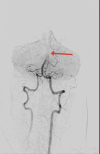Systemic Embolism From Aortic Arch Thrombus Following Warfarin Discontinuation: A Case Report
- PMID: 40530209
- PMCID: PMC12172004
- DOI: 10.7759/cureus.84319
Systemic Embolism From Aortic Arch Thrombus Following Warfarin Discontinuation: A Case Report
Abstract
We present the case of a 40-year-old female with a previous diagnosis of unprovoked deep vein thrombosis (DVT), who had been on long-term warfarin therapy but discontinued it one month before presentation. She arrived at the emergency department following two episodes of transient loss of consciousness at work, raising concerns for a possible cerebrovascular event. Further evaluation revealed evidence of systemic embolization, as she developed acute basilar artery thrombosis and left upper limb ischemia findings consistent with multiple embolic events. Computed tomography angiography (CTA) demonstrated a mural thrombus in the thoracic aorta and occlusion of the left brachial artery. The patient received intravenous recombinant tissue plasminogen activator (rTPA), followed by successful mechanical thrombectomy of the basilar artery. She was managed with systemic anticoagulation and discharged neurologically intact. This case highlights the critical importance of maintaining anticoagulation in high-risk individuals and demonstrates the potentially life-threatening consequences of abrupt discontinuation.
Keywords: anticoagulation discontinuation; basilar artery thrombosis; cerebral embolism; embolic stroke; enoxaparin; mechanical thrombectomy; mural thrombus; upper limb ischemia; warfarin cessation.
Copyright © 2025, Elrefaeei et al.
Conflict of interest statement
Human subjects: Consent for treatment and open access publication was obtained or waived by all participants in this study. Conflicts of interest: In compliance with the ICMJE uniform disclosure form, all authors declare the following: Payment/services info: All authors have declared that no financial support was received from any organization for the submitted work. Financial relationships: All authors have declared that they have no financial relationships at present or within the previous three years with any organizations that might have an interest in the submitted work. Other relationships: All authors have declared that there are no other relationships or activities that could appear to have influenced the submitted work.
Figures





Similar articles
-
Catheter-directed therapies for the treatment of high risk (massive) and intermediate risk (submassive) acute pulmonary embolism.Cochrane Database Syst Rev. 2022 Aug 8;8(8):CD013083. doi: 10.1002/14651858.CD013083.pub2. Cochrane Database Syst Rev. 2022. PMID: 35938605 Free PMC article.
-
Floating Thrombus on the Ascending Aorta and/or Aortic Arch, to Operate or Not to Operate: Two Case Reports and a Literature Review.J Cardiovasc Dev Dis. 2025 Jun 27;12(7):248. doi: 10.3390/jcdd12070248. J Cardiovasc Dev Dis. 2025. PMID: 40710773 Free PMC article. Review.
-
Effect of testing for cancer on cancer- or venous thromboembolism (VTE)-related mortality and morbidity in people with unprovoked VTE.Cochrane Database Syst Rev. 2021 Oct 1;10(10):CD010837. doi: 10.1002/14651858.CD010837.pub5. Cochrane Database Syst Rev. 2021. PMID: 34597414 Free PMC article.
-
Thrombolysis for acute ischaemic stroke.Cochrane Database Syst Rev. 2003;(3):CD000213. doi: 10.1002/14651858.CD000213. Cochrane Database Syst Rev. 2003. Update in: Cochrane Database Syst Rev. 2009 Oct 07;(4):CD000213. doi: 10.1002/14651858.CD000213.pub2. PMID: 12917889 Updated.
-
Continuation versus discontinuation of antiplatelet therapy for bleeding and ischaemic events in adults undergoing non-cardiac surgery.Cochrane Database Syst Rev. 2018 Jul 18;7(7):CD012584. doi: 10.1002/14651858.CD012584.pub2. Cochrane Database Syst Rev. 2018. PMID: 30019463 Free PMC article.
References
-
- Posterior circulation cerebrovascular syndromes: diagnosis and management. Schulz UG, Fischer U. J Neurol Neurosurg Psychiatry. 2017;88:45–53. - PubMed
-
- Clinical impact of bleeding in patients taking oral anticoagulant therapy for venous thromboembolism: a meta-analysis. Linkins LA, Choi PT, Douketis JD. Ann Intern Med. 2003;139:893–900. - PubMed
-
- Outcome in basilar artery occlusion treated with antithrombotic therapy or intra-arterial thrombolysis in the Basilar Artery International Cooperation Study (BASICS): a prospective registry study. Schonewille WJ, Algra A, Serena J, et al. Lancet Neurol. 2009;8:724–730. - PubMed
Publication types
LinkOut - more resources
Full Text Sources
